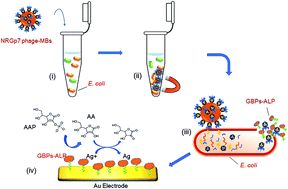Phage based electrochemical detection of Escherichia coli in drinking water using affinity reporter probes†
Abstract
The monitoring of drinking water for indicators of fecal contamination is crucial for ensuring a safe supply. In this study, a novel electrochemical method was developed for the rapid and sensitive detection of Escherichia coli (E. coli) in drinking water. This strategy is based on the use of engineered bacteriophages (phages) to separate and concentrate target E. coli when conjugated with magnetic beads, and to facilitate the detection by expressing gold binding peptides fused alkaline phosphatase (GBPs-ALP). The fusion protein GBPs-ALP has both the enzymatic activity and the ability to directly bind onto a gold surface. This binding-peptide mediated immobilization method provided a novel and simple approach to immobilize proteins on a solid surface, requiring no post-translational modifications. The concentration of E. coli was determined by measuring the activity of the ALP on gold electrodes electrochemically using linear sweep voltammetry (LSV). This approach was successfully applied in the detection of E. coli in drinking water. We were able to detect 105 CFU mL−1 of E. coli within 4 hours. After 9 hours of preincubation, 1 CFU of E. coli in 100 mL of drinking water was detected with a total assay time of 12 hours. This approach compares favorably to the current EPA method and has the potential to be applied to detect different bacteria in other food matrices.



 Please wait while we load your content...
Please wait while we load your content...